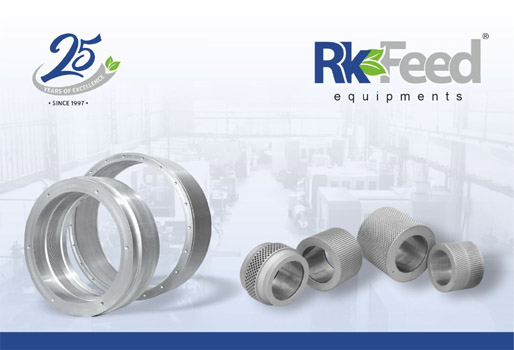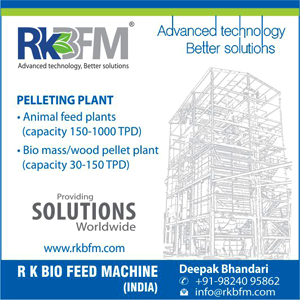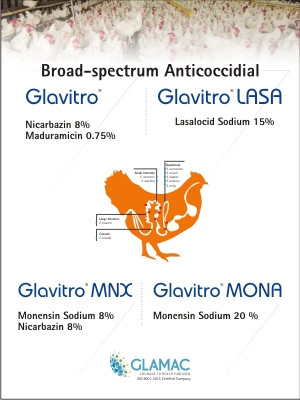The efficiency of a pellet mill is a fundamental component of the feed milling industry. The design features significantly influence not only the quality of the pellets produced but also the operational cost. A well-optimized pellet mill can improve productivity, reduce energy consumption, and enhance the overall quality of the feed, thus aiming for maximum efficiency and effectiveness.
In this article, we delve deeper into several key considerations in the design of a pellet mill, exploring aspects as below:
- Die Speed
- Feed Rate Vs Roll Speed
- Nip Angle
- Power
- Single Vs Dual Motor Concept
- Lubrication System
- Die Fitment
- Roller Adjustment
- Die and Roller Assembly
- Maintenance Practices
1. Die Speed: Die speed is a critical variable in the operation of a pellet mill, having a direct impact on both the quality of the pellets produced and the capacity of the mill. Die speed, often referred to as “peripheral speed” is typically measured at the inner diameter of the die.
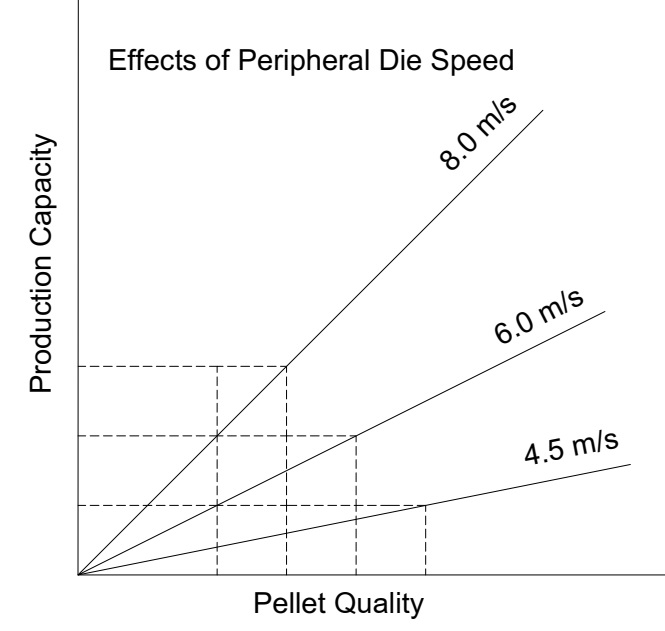
Finding the optimal die speed is a balancing act. For easy-running materials, it is advisable to maintain a die speed of approx. 8.0 – 8.5 m/sec. (Fig.1).
In contrast, harder-to-run materials benefit from a reduced die speed, often set around 6.0 – 6.5 m/sec. This lower speed minimizes vibration and stress on the machine components while also helping to reduce pellet breakage, which can occur when pellets leave the die with excessive centrifugal force.
Achieving the right die speed ultimately hinges on the interplay between production capacity and pellet quality, as higher speeds may lead to greater production but can also compromise pellet integrity and surface finish.
2. Feed Rate Vs Roll Speed
Understanding the relationship between feed rate and roll speed is essential for effective pelleting outcomes.
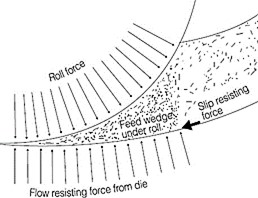
When the feed rate increases too much relative to the roll speed, the resistance posed by the material can lead to die plugging. In such cases, the rolls may push material forward instead of forcing it down into the die holes, causing slippage (Fig.2).
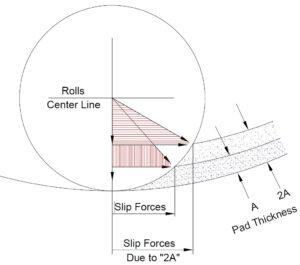
To counteract these issues, careful control of both the feed rate and the roll speed is necessary. Operators need to find a right pad thickness that allows materials to flow smoothly into the die cavity while avoiding any pressure build-up that could stall the machine (Fig.3)
3. Nip Angle
The roll first compresses & then extrudes the feed material. Hence, the nip angle is another crucial factor that influences pellet mill performance. It is defined as the angle formed by the contact point between the die and the roller (Fig.4). The nip angle directly affects how well the mill can compress and extrude feed materials.
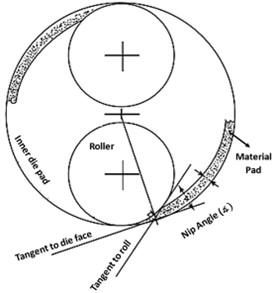
A properly designed nip angle facilitates the operation of the mill with a right pad thickness of feed material, which enhances the effectiveness of the compression and extrusion processes.
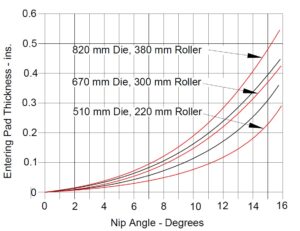
A larger die and rolls can handle a thicker feed pad, making them more energy-efficient and capable of producing higher output levels (Fig.5). Achieving the optimal nip angle is essential, as it contributes to reduced material slippage, lower energy consumption, and improved overall product quality.
4. Power
The ratio of power-to-die working surface area is a pivotal consideration. It ensures that the pellet mill is equipped with adequate power to handle the specific application while preventing over-sizing of the main motor power.
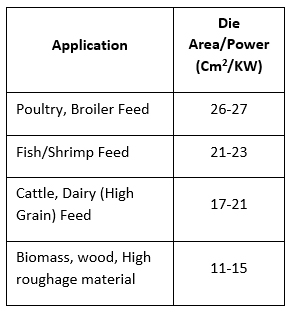 Each pellet mill is designed with a maximum power capacity in mind, and this must align with the characteristics of the materials being processed.
Each pellet mill is designed with a maximum power capacity in mind, and this must align with the characteristics of the materials being processed.
Correct motor sizing not only optimizes performance but also minimizes wear and tear on machinery, enhancing its lifespan. Engaging with experienced pellet mill manufacturers can provide insights into the ideal configurations needed for different materials.
5. Single vs. Dual Motor Concept
Motor configurations play a significant role in the overall efficiency of a pellet mill. Pellet mills typically utilize a single, larger motor, which is more efficient in converting electrical energy into mechanical power when compared to double smaller motors.
The single motor arrangement can lead to reduced energy consumption and simpler maintenance processes. On the other hand, some belt-driven machines employ dual motors to distribute power. This setup complicates load sharing and overall drive system balance.
Dual motors have performance mismatch, resulting in one motor working harder than the other. Therefore, selecting between single and dual motor setups must consider operational demands, complexity, maintenance convenience, and overall efficiency.
6. Lubrication System
The lubrication system is a vital aspect of any pellet mill, as it directly affects the longevity and reliability of mechanical components.
Lubrication in belt-driven systems often involves periodic greasing, necessitating periodic maintenance strategies. A high-performing lubrication system minimizes friction and wear on parts, thereby enhancing machine reliability and operational efficiency. In contrast, gear-driven pellet mills are equipped with oil lubrication system to cool, filter oil & lubricate the moving parts.
7. Die Fitment
The manner in which dies are fitted onto the pellet mill is vital, as it directly affects operational efficiency.
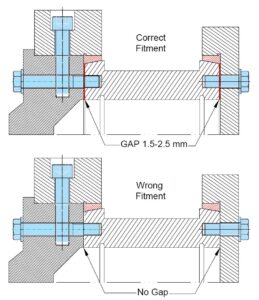
There are two primary methods for die mounting: bolting and clamping. Each has its advantages and disadvantages. Clamp systems allow for quicker and more user-friendly die changes, reducing downtime and maximizing productivity.
In contrast, bolted systems often require more time, especially when stiffening rings must be removed and replaced during the process. The choice between these systems depends on operational specifics, including the size and type of dies in use, and the overall requirements of the production process.
Correct die fitment is essential for achieving near-zero breakage of the die. Bolted system facilitates reversal of die which results in uniform wear for both die and rolls & hence more die and roll usage life. In typical taper fitment the gap between the die face and matching part face ensures tight and correct fitment (Fig.6).
8. Roller Adjustment
Proper roller adjustment is critical for ensuring that the rollers maintain the correct clearance between themselves and the die face.
This adjustment is key to preventing metal-to-metal contact, which could significantly reduce the lifespan of both rollers and die. Traditional manual adjustments require operators to stop the machine & slightly adjust the roll gap.

Fig.7, shows the correct way to decrease/increase the roll gap. Nowadays, bigger pellet mills have a remote adjustment system which enables operators to adjust continuously roll position during operation for better pellet quality and performance.
9. Die and Roller Assembly
The die and roller assembly represents a core component of the pellet mill where the actual pelleting occurs. There are two zones – compression zone & extrusion zone (Fig.8).
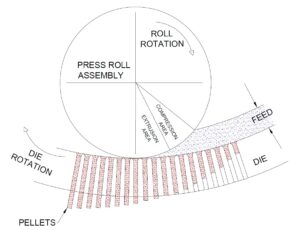
A typical arrangement may involve two or three rollers, but studies have shown that two-large-roll systems often yield higher production levels when compared to their three-roll counterparts.
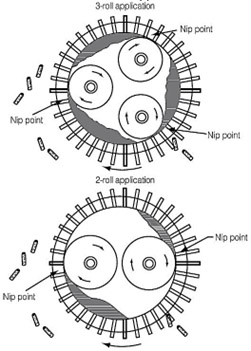
Although the 3-roll configuration aims to avoid die stress and improve consistency. Die and roller designs can be optimized to withstand production loads with two rolls, offering a more energy-efficient solution. Hence, manufacturing processes must focus on achieving a streamlined approach and efficient die and roller design to improve throughput and reduce energy consumption.
10. Maintenance Practices
Implementing a comprehensive maintenance regimen is vital for sustaining the operational efficiency and lifespan of the pellet mill. Regular inspections should encompass lubrication system, wear parts like rollers and dies, and the overall integrity of mechanical components, including main bearings, belts, gears and other drive parts.
Establishing a preventative maintenance routine, which includes periodic removal of old grease, replacing worn-out bearings, and checking for misalignments, helps prevent costly downtime due to unexpected breakdowns. Additionally, training operators in best maintenance practices ensures and identifies potential issues before they become significant problems. This proactive approach ensures productivity but also significantly mitigates operational risks.
11. Conclusion
In conclusion, the design of a pellet mill is a complex interplay of various critical operational aspects, encompassing die speed, feed rates, nip angles, power requirements, motor configurations, lubrication systems, die fitment, roller adjustments, die and roller assembly, and maintenance practices.
By comprehensively understanding and optimizing each of these elements, operators can achieve a more efficient, reliable, and cost-effective pellet production process. Continuous collaboration with manufacturers and adherence to optimal machine specifications will undoubtedly lead to enhanced pellet quality, reduced operational costs, and improved production outcomes. This level of diligence and efficiency is not just an industry standard but a necessary strategy for success in today’s competitive environment.
Company Details:
RKBFM (R K BIO FEED MACHINE) is committed to providing top-notch solutions in the design, manufacturing, and supply of world-class feed plants, machinery, and spares.

Co-founder
Co-founded by Mr. Deepak Bhandari in 1997, RKBFM started as a feed mill spares’ manufacturing unit and expanded into a turnkey solution provider with state-of-the-art manufacturing facilities for the global pelleting industry.
Website: www.rkbfm.com
Facebook: @rkbfm29
LinkedIn: @r-k-bio-feed-machine


